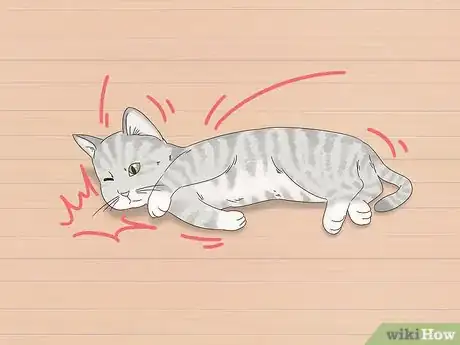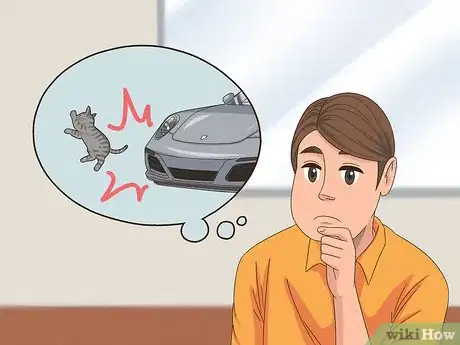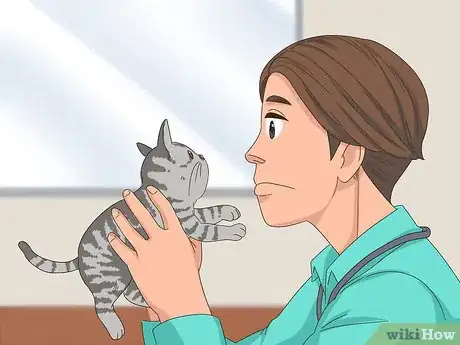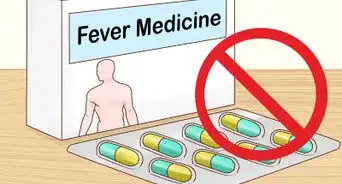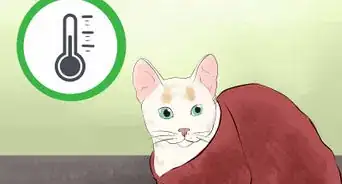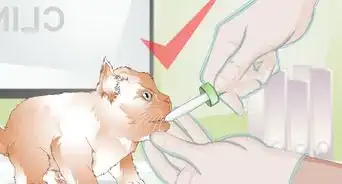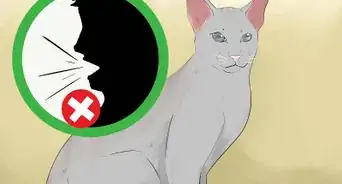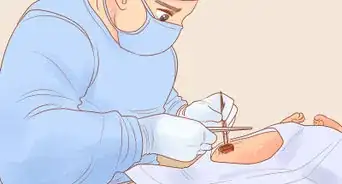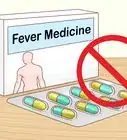This article was co-authored by Lauren Baker, DVM, PhD. Dr. Lauren Baker is a Veterinarian and Assistant Scientist at the University of Wisconsin-Madison. With over 10 years in veterinary medicine, she specializes in the concept of “one health,” which uses insights from veterinary medicine to help human medical research. She holds a Ph.D. in Comparative Biomedical Sciences, a Doctor of Veterinary Medicine, an MS in Comparative Biomedical Sciences, and a Bachelor’s degree in Psychology from the University of Wisconsin-Madison.
This article has been viewed 15,885 times.
Horner’s Syndrome is a neurological condition that occurs in cats as result of damage to the nervous system. Horner's Syndrome can be caused by multiple medical conditions, including middle ear infections, tumors in the chest, neck, or brain, or traumatic brain injury.[1] By carefully monitoring your cat’s body – particularly their eyes – and behavior, you can diagnose Horner’s. Taking your cat to the vet and following their advice for treatment can help you make your cat more comfortable.
Steps
Diagnosing Homer’s Syndrome
-
1Look for changes to your cat's eyes or eyelids. Most of the visible signs of Horner’s Syndrome will appear in your cat’s eyes. You might notice drooping eyelids, unequal pupils, and sunken eyes. The area around your cat’s eyes may be red and warm to the touch.[2]
-
2Watch to see if your cat stumbles. If your cat is suffering from damage to the nervous system in the lower neck, it may have trouble controlling its limbs. If you notice your cat stumbling when they walk in combination with the above symptoms, they might have Horner's Syndrome. Your cat might also tilt its head to one side or the other.[3]Advertisement
-
3Consider potential head trauma. Because Horner's is sometimes caused by head trauma, consider if that's a possibility with your cat. Was your cat hit by a car? Was your cat in the car with you when you got into a car accident? Did it get hurt by another animal? These could all cause Horner's.[4]
-
4Take cat to vet for examination. To fully diagnose Horner's, your cat needs to have a complete physical examination.Your vet will be able to identify Horner’s in your cat and run tests to determine the cause. Tests might include a neurologic evaluation, x-rays, otoscopic examination, or blood work.[5]
Treating Homer’s Syndrome
-
1Apply eye medication. Because Horner's can prevent your cat from blinking normally, your vet may prescribe eye lubricant to make their eyes more comfortable. You should give this medication to your cat as instructed by your vet.[6]
- Phenylephrine eyedrops are sometimes prescribed to help alleviate symptoms while your cat undergoes treatment for the main cause of the condition.
-
2Administer ear medication. You cat’s Horner’s may be caused by an inner ear infection. If this is the case, your vet will prescribe medication to treat the ear infection. Give this medication as instructed by your vet.[7]
-
3Schedule surgery. Your cat might require surgery, particularly if the Horner's Syndrome is caused by tumors. If this is the case, your vet will perform a physical examination on your cat to determine if surgery is an option. If it is, your vet will give your cat a general anesthetic and perform surgery to remove the tumor. Your vet will also provide you with a list of at-home care instructions for after the surgery.[8]
- You should check the incision daily for bleeding or swelling, as this can be a sign of infection.
- Your vet may not perform surgery if he or she determines that the symptoms your cat is experiencing are less traumatic than surgery might be.
-
4Administer an anti-inflammatory medication. Your cat might suffer from inflammation around the eye from Horner’s. If this is the case, your vet might recommend you give your cat an anti-inflammatory drug to reduce the swelling.[9]
- Many anti-inflammatory drugs can be dangerous to cats if the dose is too large or cats take them for too long. Make sure you carefully follow your vet's instructions if they prescribe anti-inflammatory drugs.[10]
-
5Schedule other treatments. Because Horner's Syndrome can be both a condition by itself and a sign that something else is wrong, the treatment your vet prescribes will vary. Talk to your vet to get the best information possible regarding treatment options for your cat.
Warnings
- Horner’s Syndrome is usually the manifestation of much more serious issues. If your cat develops Horner’s, you should not wait for the issue to resolve itself.⧼thumbs_response⧽
References
- ↑ https://vcahospitals.com/know-your-pet/horners-syndrome-in-cats
- ↑ https://www.vetary.com/cat/condition/horners-syndrome
- ↑ https://www.vetary.com/cat/condition/horners-syndrome
- ↑ https://www.vetary.com/cat/condition/horners-syndrome
- ↑ https://www.vetary.com/cat/condition/horners-syndrome
- ↑ https://vcahospitals.com/know-your-pet/horners-syndrome-in-cats
- ↑ https://vcahospitals.com/know-your-pet/horners-syndrome-in-cats
- ↑ https://www.vetary.com/cat/condition/horners-syndrome
- ↑ http://www.eyecareforanimals.com/conditions/horners-syndrome/
About This Article
To diagnose Horner’s Syndrome in cats, look for drooping eyelids, unequal pupils, and sunken eyes. The condition is usually caused by head trauma, so consider whether your cat has been injured recently. Because Horner’s Syndrome affects cats’ nervous systems, check to see if your cat is stumbling or having trouble controlling its limbs. If your cat shows any of these symptoms, take it to the vet to be examined. To treat Horner’s Syndrome, your vet may prescribe eye drops since the condition can prevent your cat from blinking. They might also give your cat anti-inflammatory medicine to treat any eye inflammation. If the condition is caused by a tumor, your vet might recommend surgery to have the tumor removed. For more tips from our Veterinary co-author, like how to care for your cat after its surgery, keep reading!

